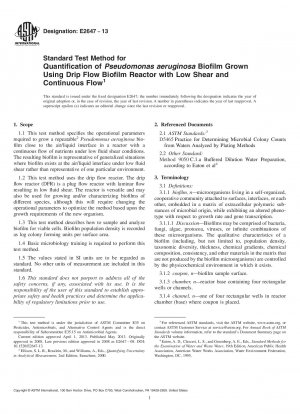ASTM E2647-13
Standard Test Method for Quantification of Pseudomonas aeruginosa Biofilm Grown Using Drip Flow Biofilm Reactor with Low Shear and Continuous Flow
- Standard No.
- ASTM E2647-13
- Release Date
- 2013
- Published By
- American Society for Testing and Materials (ASTM)
- Status
- Replace By
- ASTM E2647-20
- Latest
- ASTM E2647-20
- Scope
5.1 Vegetative biofilm bacteria are phenotypically different from suspended cells of the same genotype. Biofilm growth reactors are engineered to produce biofilms with specific characteristics. Altering either the engineered system or operating conditions will modify those characteristics.
5.2 The purpose of this test method is to direct a user in how to grow, sample, and analyze a P. aeruginosa biofilm under low fluid shear and close to the air/liquid interface using the DFR. The P. aeruginosa biofilm that grows has a smooth appearance and is loosely attached. Microscopically, the biofilm is sheet-like with few architectural details. This laboratory biofilm could represent those found on produce sprayers, on food processing conveyor belts, on catheters, in lungs with cystic fibrosis, and oral biofilms, for example. The biofilm generated in the DFR is also suitable for efficacy testing. After the 54 h growth phase is complete, the user may add the treatment in8201;situ or harvest the coupons and treat them individually. Research has shown that P. aeruginosa biofilms grown in the DFR were less tolerant to disinfection than biofilms grown under high shear conditions.5
1.1 This test method specifies the operational parameters required to grow a repeatable2 Pseudomonas aeruginosa biofilm close to the air/liquid interface in a reactor with a continuous flow of nutrients under low fluid shear conditions. The resulting biofilm is representative of generalized situations where biofilm exists at the air/liquid interface under low fluid shear rather than representative of one particular environment.
1.2 This test method uses the drip flow reactor. The drip flow reactor (DFR) is a plug flow reactor with laminar flow resulting in low fluid shear. The reactor is versatile and may also be used for growing and/or characterizing biofilms of different species, although this will require changing the operational parameters to optimize the method based upon the growth requirements of the new organism.
1.3 This test method describes how to sample and analyze biofilm for viable cells. Biofilm population density is recorded as log colony forming units per surface area.
ASTM E2647-13 Referenced Document
- ASTM D5465 Standard Practice for Determining Microbial Colony Counts from Waters Analyzed by Plating Methods
ASTM E2647-13 history
- 2020 ASTM E2647-20 Standard Test Method for Quantification of
Pseudomonas aeruginosa Biofilm Grown Using Drip Flow Biofilm Reactor with Low Shear and Continuous Flow - 2013 ASTM E2647-13 Standard Test Method for Quantification of
Pseudomonas aeruginosa Biofilm Grown Using Drip Flow Biofilm Reactor with Low Shear and Continuous Flow - 2008 ASTM E2647-08 Standard Test Method for Quantification of a Pseudomonas aeruginosa Biofilm Grown Using a Drip Flow Biofilm Reactor with Low Shear and Continuous Flow
